Attached files
| file | filename |
|---|---|
| 8-K - 8-K - Amerant Bancorp Inc. | amtb-20201105.htm |

Investor Presentation As of September 30, 2020
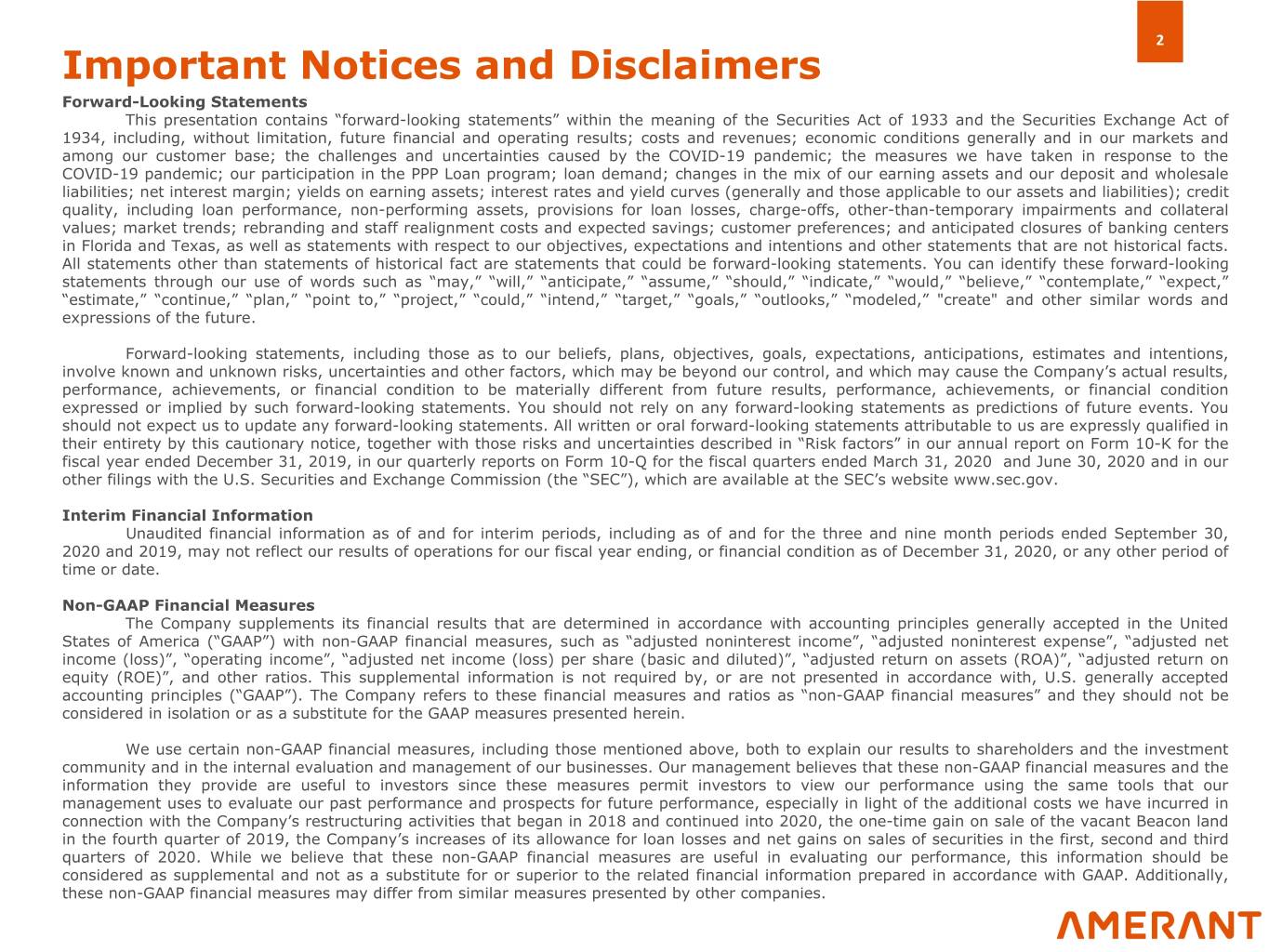
2 Important Notices and Disclaimers Forward-Looking Statements This presentation contains “forward-looking statements” within the meaning of the Securities Act of 1933 and the Securities Exchange Act of 1934, including, without limitation, future financial and operating results; costs and revenues; economic conditions generally and in our markets and among our customer base; the challenges and uncertainties caused by the COVID-19 pandemic; the measures we have taken in response to the COVID-19 pandemic; our participation in the PPP Loan program; loan demand; changes in the mix of our earning assets and our deposit and wholesale liabilities; net interest margin; yields on earning assets; interest rates and yield curves (generally and those applicable to our assets and liabilities); credit quality, including loan performance, non-performing assets, provisions for loan losses, charge-offs, other-than-temporary impairments and collateral values; market trends; rebranding and staff realignment costs and expected savings; customer preferences; and anticipated closures of banking centers in Florida and Texas, as well as statements with respect to our objectives, expectations and intentions and other statements that are not historical facts. All statements other than statements of historical fact are statements that could be forward-looking statements. You can identify these forward-looking statements through our use of words such as “may,” “will,” “anticipate,” “assume,” “should,” “indicate,” “would,” “believe,” “contemplate,” “expect,” “estimate,” “continue,” “plan,” “point to,” “project,” “could,” “intend,” “target,” “goals,” “outlooks,” “modeled,” "create" and other similar words and expressions of the future. Forward-looking statements, including those as to our beliefs, plans, objectives, goals, expectations, anticipations, estimates and intentions, involve known and unknown risks, uncertainties and other factors, which may be beyond our control, and which may cause the Company’s actual results, performance, achievements, or financial condition to be materially different from future results, performance, achievements, or financial condition expressed or implied by such forward-looking statements. You should not rely on any forward-looking statements as predictions of future events. You should not expect us to update any forward-looking statements. All written or oral forward-looking statements attributable to us are expressly qualified in their entirety by this cautionary notice, together with those risks and uncertainties described in “Risk factors” in our annual report on Form 10-K for the fiscal year ended December 31, 2019, in our quarterly reports on Form 10-Q for the fiscal quarters ended March 31, 2020 and June 30, 2020 and in our other filings with the U.S. Securities and Exchange Commission (the “SEC”), which are available at the SEC’s website www.sec.gov. Interim Financial Information Unaudited financial information as of and for interim periods, including as of and for the three and nine month periods ended September 30, 2020 and 2019, may not reflect our results of operations for our fiscal year ending, or financial condition as of December 31, 2020, or any other period of time or date. Non-GAAP Financial Measures The Company supplements its financial results that are determined in accordance with accounting principles generally accepted in the United States of America (“GAAP”) with non-GAAP financial measures, such as “adjusted noninterest income”, “adjusted noninterest expense”, “adjusted net income (loss)”, “operating income”, “adjusted net income (loss) per share (basic and diluted)”, “adjusted return on assets (ROA)”, “adjusted return on equity (ROE)”, and other ratios. This supplemental information is not required by, or are not presented in accordance with, U.S. generally accepted accounting principles (“GAAP”). The Company refers to these financial measures and ratios as “non-GAAP financial measures” and they should not be considered in isolation or as a substitute for the GAAP measures presented herein. We use certain non-GAAP financial measures, including those mentioned above, both to explain our results to shareholders and the investment community and in the internal evaluation and management of our businesses. Our management believes that these non-GAAP financial measures and the information they provide are useful to investors since these measures permit investors to view our performance using the same tools that our management uses to evaluate our past performance and prospects for future performance, especially in light of the additional costs we have incurred in connection with the Company’s restructuring activities that began in 2018 and continued into 2020, the one-time gain on sale of the vacant Beacon land in the fourth quarter of 2019, the Company’s increases of its allowance for loan losses and net gains on sales of securities in the first, second and third quarters of 2020. While we believe that these non-GAAP financial measures are useful in evaluating our performance, this information should be considered as supplemental and not as a substitute for or superior to the related financial information prepared in accordance with GAAP. Additionally, these non-GAAP financial measures may differ from similar measures presented by other companies.
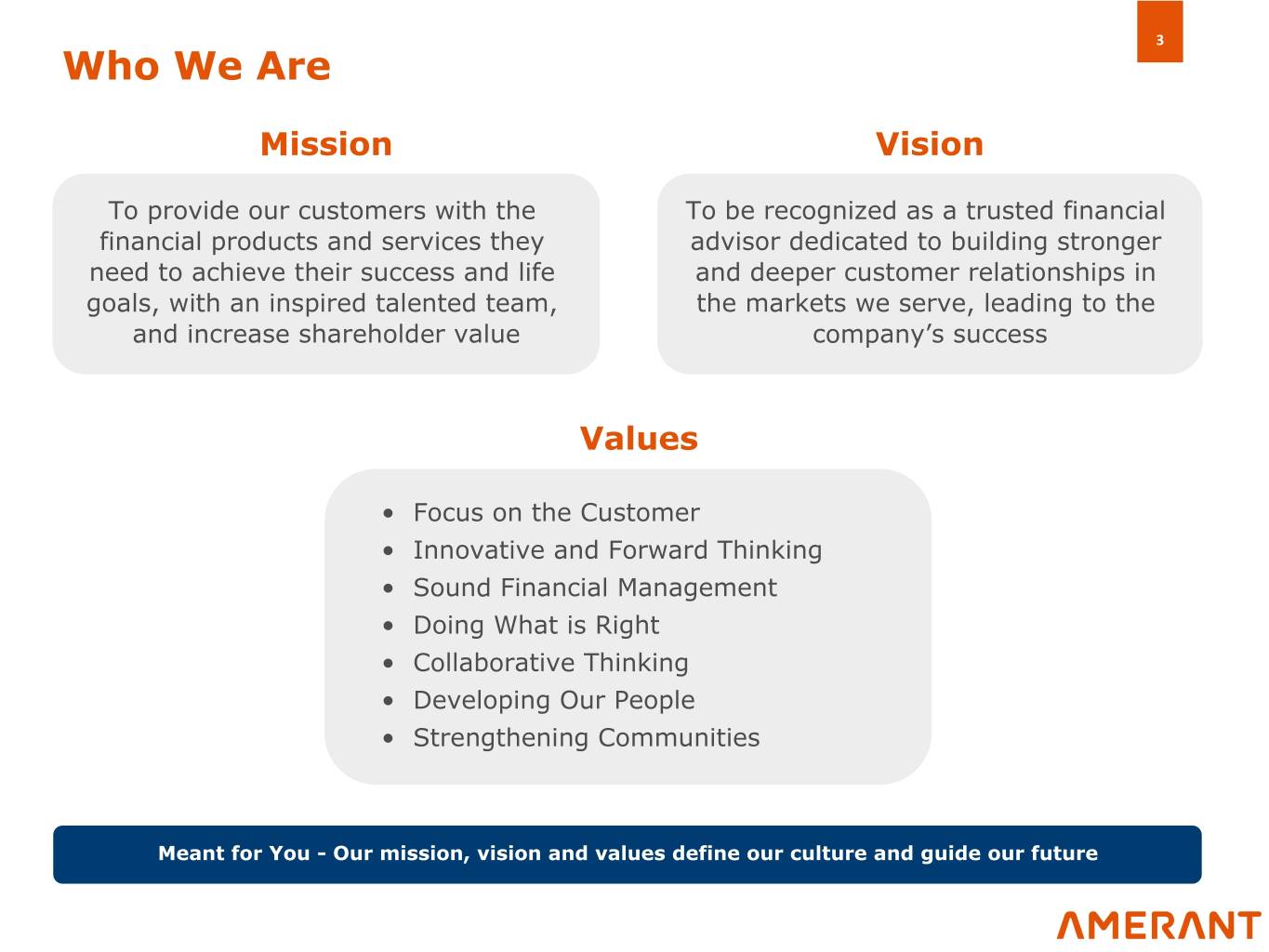
3 Who We Are Mission Vision To provide our customers with the To be recognized as a trusted financial financial products and services they advisor dedicated to building stronger need to achieve their success and life and deeper customer relationships in goals, with an inspired talented team, the markets we serve, leading to the and increase shareholder value company’s success Values • Focus on the Customer • Innovative and Forward Thinking • Sound Financial Management • Doing What is Right • Collaborative Thinking • Developing Our People • Strengthening Communities Meant for You - Our mission, vision and values define our culture and guide our future

4 About Us Financial Highlights (in millions, except per share data • Founded in 1979 2015 2016 2017 2018 2019 3Q20 YTD (1) and percentages) • Acquired in 1987 by MSF Balance Sheet • 80.1% spin-off in Aug. 2018 Assets $ 8,163 $ 8,434 $ 8,437 $ 8,124 $ 7,985 $ 7,977 • Completed IPO in Dec. 2018 History Loans 5,623 5,765 6,066 5,920 5,744 5,925 • Rebranded as Amerant in June 2019 Deposits 6,520 6,577 6,323 6,033 5,757 5,878 • MSF no longer has stake in the Tangible Common Equity (2)(3) 661 683 732 726 813 808 Company Income Statement Net Income (Loss) $ 15.0 $ 23.6 $ 43.1 $ 45.8 $ 51.3 $ (10.2) (3) Headquarters • Coral Gables, FL Adjusted Net Income (Loss) $ 15.0 $ 23.6 $ 48.4 $ 57.9 $ 53.1 $ (7.4) Operating income (3) $ 33.7 $ 54.9 $ 72.0 $ 56.9 $ 63.5 $ 49.8 Net Income (Loss) per Share - Basic $ 0.35 $ 0.55 $ 1.01 $ 1.08 $ 1.21 $ (0.24) (8) Adjusted Net Income (Loss) per Employees • 807 FTEs $ 0.35 $ 0.55 $ 1.14 $ 1.36 $ 1.25 $ (0.18) Share - Basic (3) • 25 branches throughout South ROA 0.19 % 0.29 % 0.51 % 0.55 % 0.65 % (0.17) % Adjusted ROA (3) 0.19 % 0.29 % 0.57 % 0.69 % 0.67 % (0.12) % Footprint Florida and Houston, with loan production offices in New York, NY ROE 2.14 % 3.29 % 5.62 % 6.29 % 6.43 % (1.62) % Adjusted ROE (3) 2.14 % 3.29 % 6.32 % 7.95 % 6.66 % (1.17) % and Dallas, TX (7) Efficiency Ratio (4) 84.7 % 78.0 % 73.8 % 78.8 % 77.5 % 62.7 % Adjusted Efficiency Ratio (3)(4) 84.7 % 78.0 % 74.8 % 74.0 % 76.4 % 60.9 % Market Share • Second largest community bank headquartered in Florida Capital Tier 1 Common Ratio 10.1 % 10.3 % 10.7 % 11.1 % 12.6 % 12.3 % Assets • $7.98 billion Tier 1 Capital Ratio 11.8 % 11.9 % 12.3 % 12.7 % 13.9 % 13.3 % Total Risk-based Capital 12.9 % 13.1 % 13.3 % 13.5 % 14.8 % 14.6 % Tangible Common Equity Ratio 8.1 % 8.1 % 8.7 % 9.0 % 10.2 % 10.2 % Deposits • $5.88 billion Stockholders' book value per common $ 16.06 $ 16.59 $ 17.73 $ 17.31 $ 19.35 $ 19.68 share Tangible Book Value per Common $ 15.56 $ 16.08 $ 17.23 $ 16.82 (2) $ 18.84 $ 19.17 AUM • $1.8 billion under management/ Share (3) custody Credit Non-performing Assets (5) / Assets 0.95 % 0.85 % 0.32 % 0.22 % 0.41 % 1.08 % Net charge offs (Recoveries) / Geographic Mix (0.01) % 0.32 % 0.11 % 0.18 % 0.11 % 0.56 % Average Total Loans (6) September 30, 2020 Loans Deposits (1) Mercantil Servicios Financieros, C.A. (“MSF”), the Company's former parent company (2) Reflects special one-time dividend of $40.0 million paid on March 13, 2018 to MSF in connection with the spin-off (3) See Appendix 2 ”Non-GAAP Financial Measures Reconciliations" for a reconciliation of these non-GAAP financial measures to their 3% GAAP counterparts. There were no non-GAAP adjustments in 2015 and 2016 44% (4) Efficiency ratio and adjusted efficiency ratio are the result of noninterest expense and adjusted noninterest expense, respectively divided by the sum of noninterest income and net interest income (5) Non-performing assets include all accruing loans past due 90 days or more, all nonaccrual loans, restructured loans that are considered “troubled debt restructurings” or “TDRs”, and OREO properties acquired through or in lieu of foreclosure (6) Calculated based upon the average daily balance of outstanding loan principal balance net of deferred loan fees and costs, excluding the allowance for loan losses (7) The Company closed one banking center in Florida, and another in Texas, on October 30, 2020 56% (8) On October 9, 2020, the Company implemented voluntary early retirement plan ("VERP") and involuntary severance plan ("ISP") 97% to be completed by year end. VERP employees have 45 days to confirm participation. Costs and savings determined after this point. ISP will affect approximately 37 persons. ISP expected cost of approximately $1.9 million in the fourth quarter of 2020 and Domestic International estimated annual savings of approximately $5.8 million. Since 2015, the Company has reduced FTEs by 19.9%

5 Investment Opportunity Highlights Established Strong and Well-Positioned Significant Fee Pathway to Franchise in Diverse Deposit Loan Income Strong Attractive Portfolio Markets Base Platform Profitability • Long history with • Combination of • Loan book well- • Wealth management • Dynamic initiatives strong reputation domestic and low- diversified across and brokerage to improve ROA/ and deep client cost international various asset platform with ROE through relationships deposits classes and markets accompanying trust efficiency, fee and private banking income, and other • Presence in high- • Growing customer • Outstanding credit capabilities levers growth markets of deposit base performance due to Florida, Texas, and (approximately 11% disciplined • Approximately • Proactive strategy New York CAGR since 2015) underwriting culture 20.3% noninterest to enhance financial income/total performance as part (2) • Seasoned • Low-cost • High level of operating revenue of a multi-year shift management team international relationship lending in the nine months towards increasing customer deposit are ended September core domestic and board with long • Solid risk a strategic 30, 2020 (3) growth and tenure management to advantage (0.35% profitability • Second largest average cost in the allow adjustments • Adaptive product community bank first nine months of based on market lineup to increase • Ongoing digital headquartered in 2020) conditions fee income transformation to Florida (1) and one adapt to a new of the leading banks • Retaining competitive serving the Hispanic international environment community in the deposits by adding markets we serve new and revamped product bundles and services, and improved customer journey (1) Community banks include those with less than $10 billion in assets. Source:S&P Market Intelligence - September 2020 (2) Operating revenue is the result of net interest income before provision for loan losses plus noninterest income. Noninterest income excludes all securities gains and losses ($26.0 million net gain in the first nine months of 2020) (3) See Appendix 2 ”Non-GAAP Financial Measures Reconciliations" for a reconciliation of this non-GAAP financial measures to its GAAP counterpart

6 Experienced Management Team • Chairman since January 2019 Frederick Copeland • Director of Company and Bank from 2007 to 2018 • Former President and CEO of Far East National Bank Chairman of the Board • Former President and CEO of Aetna International, Inc. 79 years old • Former Chairman, President, and CEO of Fleet Bank, N.A. Connecticut • Former President and CEO of Citibank Canada Millar • CEO since 2009, Vice-Chairman since 2013 and Director since 1987 of Company and Wilson Bank • Spearheaded MSF's entry into the U.S. in 1983 Vice-Chairman & CEO • 42 years of experience with MSF/Amerant Bancorp ("AMTB"), including Executive 68 years old Director of International Business • Director of the Federal Reserve Bank of Atlanta-Miami Branch from 2013 to 2018 Carlos • CFO since May 2020 Iafigliola • 22 years with MSF / AMTB Executive Vice President & • Head of Treasury from 2015 to April 2020 Chief Financial Officer • Asset & Liability Manager at AMTB from 2004 to 2015 44 years old • Served in Market Risk Management at MSF 1998 to 2004 Alfonso • President and COO since February 2018 Figueredo President & Chief Operating • 32 years with MSF / AMTB Officer • Executive Vice President of Operations and Administration of MSF from 2015 to 2018 • CFO of MSF from 2008 to 2015 59 years old Alberto • Executive Vice President and Chief Risk Officer since 2015 Capriles Executive Vice President • 25 years with MSF / AMTB & Chief Risk Officer • Corporate Treasurer of MSF from 2008 to 2015 • Corporate Market Risk Manager of MSF from 1999 to 2008 53 years old Miguel • Executive Vice President and Chief Business Officer since February 2018 Palacios • All 28 years of banking experience spent with MSF / AMTB Executive Vice President • Domestic Personal and Commercial Manager from 2012 to 2018 & Chief Business Officer • Special Assets Manager from 2009 to 2012 52 years old

7 Market Strategy Our strategy is to operate and expand in high-growth, diverse economies where we can build from our heritage serving the Hispanic community Miami-Dade MSA Target markets have: • Major industry sectors are trade, tourism, services, manufacturing, education, and real estate • Substantial domestic deposit growth • Unemployment rate of 13.6% as of August 2020 potential • Ranked #1 MSA for startup activity by the 2017 Kauffman Index among the 39 largest MSAs • Diversified industries, requiring high-quality loans (1) Houston MSA • Major industry sectors of health care, retail, oil/gas, • Population growth, and thus a travel, and services larger number of potential • Unemployment rate of 8.1% as of August 2020 customers • Home to the world’s largest medical complex. Ranks #2 in manufacturing GDP nationwide • Customers that require more than one of our banking services NYC MSA • Major industry sectors of education, health care, • Existing, significant Hispanic tourism, financial services, and professional / communities that value our business services bilingual employees and services • Unemployment rate of 15.4% as of August 2020 • MSA has #1 GDP in the nation Our markets are diverse with growing demographics and industry (1) See "Supplemental Information COVID-19" Sources: S&P Global Market Intelligence. US Bureau of Labor Statistics. Greater Houston Partnership (www.Houston.org). Business Facilities’ 2018 Metro Rankings Report. US Bureau of Economic Analysis. Center for Governmental Research

Growing and Diverse Markets 8 Branch Footprint (1) Deposit Market Share (2) Market Demographics October 31, 2020 June 30, 2020 2010 – 2020 Est. Population Change 18 banking centers Deposits % of Market 21.1% Market Branches ($mm) AMTB Share % 13.7% Miami-Dade, FL (3) 10 $4,992 81.4 3.1 7.0% Broward, FL 6 361 5.9 0.6 Florida Miami Houston U.S. Palm Beach, FL 3 124 1.7 0.2 2020 – 2025 Median Est. Household Income Change Florida 19 $5,477 89.0 % 1.9 % 11.5% 9.9% 7 banking centers 2.8% Deposits % of Market Market Branches ($mm) AMTB Share % Miami Houston U.S. (4)(5) (6) Harris, TX 7 $577 9.5 0.2 2020 – 2025 Est. Population Change 7.5% 6.3% Montgomery, TX 1 77 1.5 0.5 Texas 3.3% Texas 8 $654 11.0 % 0.2% Miami Houston U.S. Amerant is growing in attractive markets and is the largest community bank in the Miami-Dade MSA (7) (1) The Company closed one banking center in Florida, and another in Texas, on October 30, 2020 (2) Deposit Market Share data and number of branches is as of June 30, 2020. For the current number of branches see Branch Footprint (3) Includes brokered deposits of $588 million as of June 30, 2020 (4) Includes the Katy, TX branch. The city of Katy is in Harris, Fort Bend, and Waller Counties and the new facility serves nearby areas of these counties (5) Our Sugar Land, TX branch also serves Fort Bend County and our Katy, TX branch lies adjacent to this market (6) In January 2019, the Bank opened a Loan Production Office in Dallas, Texas (7) Community banks include those with less than $10 billion in assets Sources: Deposit data from FDIC as of June 30, 2020 (Bank-level). Market demographics, and county data and market share from S&P Global. Market Intelligence as of June 30, 2020

9 Value Proposition and Brand Attributes High Touch Service • Dynamic • Adaptable Meant for You • Attentive • Diligent • Responsive • Innovative By leveraging our experience and knowledge, we proactively Trustworthy anticipate your financial needs based on where you are and • Dependable where you plan to go. We appreciate that everyone’s journey • Insightful and goals are different, and our commitment is to inspire you • Solid and support you along the way. • Transparent • Reliable We combine traditions and innovations to offer a diverse portfolio of financial solutions to meet your evolving preferences and priorities. Community Orientation You have choices to create a relationship that is uniquely • Caring yours and backed by a team of financial partners that share • Responsible your sense of community and a vision for what’s ahead. • Committed • Inspiring • Purposeful Everything we do is designed with our stakeholders in mind

10 Ongoing Business Transformation From... To... Part of a diverse international financial group, with Focused on traditional community banking business a sophisticated international customer base in the U.S. and an international business to service valued relationships A number of non-core products and services were No ongoing commercial or shared services offered as a result of the relationship relationships with former parent with former parent Loan growth in a refined U.S. product suite and Wide range of lending products with diverse tightened credit standards have led to much underwriting standards improved credit performance(1) Double-digit cumulative growth of domestic deposits Depositor base comprised substantially of over the last five years while continuing to benefit individuals and corporations outside of the U.S. from low cost international deposit base Value proposition focused on expanding presence Value proposition “in development” and strong within target U.S. communities and strengthening reliance on “non-relationship” assets and liabilities relationships (share of wallet) Pivot from an internationally focused bank to a traditional community bank with a Latin American heritage (1) See "Supplemental Information COVID-19"

11 Summary of Our Strategic Plan Building on our strengths to shape our future Domestic focus Expanding Growth in Core, Increased with an Strong Credit Business and Domestic Profitability International Culture(1) Geographic Deposits and Returns Heritage Presence ▪ Grow U.S. ▪ Completed exit ▪ Continue strong ▪ Completed ▪ Improve cross- presence and higher-risk and domestic deposit strategic footprint selling initiatives, enhance market less attractive growth through a expansion including scalable share in existing businesses wealth high-touch, ▪ Utilization of and adjacent management ▪ Pursue targeted needs-based Online CDs as a markets platform lending approach channel to raise ▪ Protect and serve opportunities ▪ Improve deposit out of footprint ▪ Ongoing expense valuable within prudent account deposits rationalization and international credit guidelines efficiency penetration of the ▪ Focus on customer base initiatives ▪ Refined product commercial increased share of ▪ Enhance multi- suite targeting customer base wallet and non- ▪ Focus on channel client selected domestic ▪ Enhance retail and lending products solidifying experience with customers and commercial sales from existing presence in target improved branch verticals/niches with consultative client base U.S. communities experience sales approach ▪ Expand wealth ▪ Initiatives to ▪ Replace low and improved management increase domestic yielding foreign banking centers client acquisition fee income loans with higher and cross-selling generation margin domestic opportunities loans (completed in 2019) Creating shareholder value through the implementation of a multi-dimensional strategic plan (1) See "Supplemental Information COVID-19"
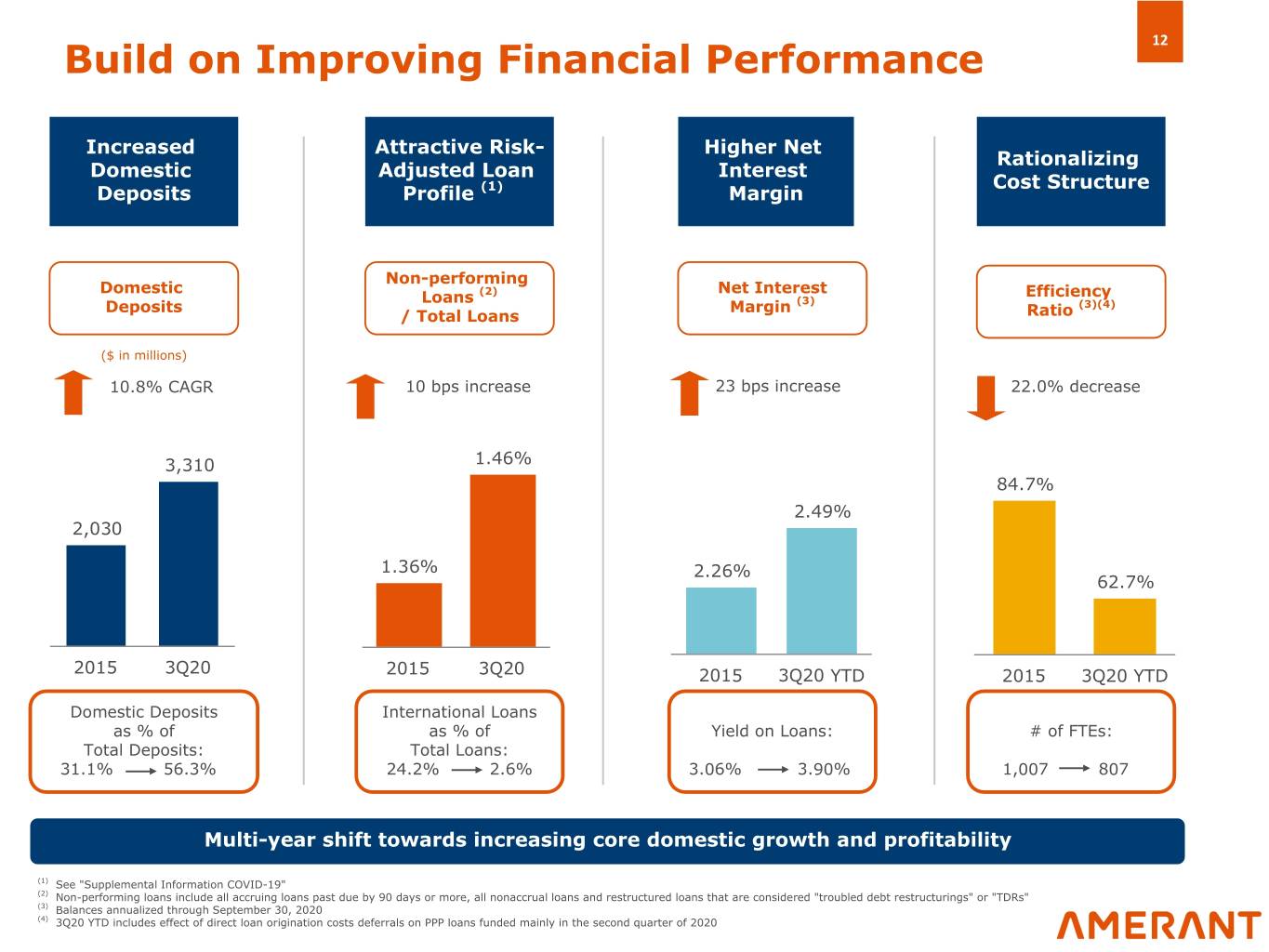
12 Build on Improving Financial Performance Increased Attractive Risk- Higher Net Rationalizing Domestic Adjusted Loan Interest Cost Structure Deposits Profile (1) Margin Non-performing Domestic Net Interest Loans (2) Efficiency Deposits Margin (3) (3)(4) / Total Loans Ratio ($ in millions) 10.8% CAGR 10 bps increase 23 bps increase 22.0% decrease 3,310 1.46% 84.7% 2.49% 2,030 1.36% 2.26% 62.7% 2015 3Q20 2015 3Q20 2015 3Q20 YTD 2015 3Q20 YTD Domestic Deposits International Loans as % of as % of Yield on Loans: # of FTEs: Total Deposits: Total Loans: 31.1% 56.3% 24.2% 2.6% 3.06% 3.90% 1,007 807 Multi-year shift towards increasing core domestic growth and profitability (1) See "Supplemental Information COVID-19" (2) Non-performing loans include all accruing loans past due by 90 days or more, all nonaccrual loans and restructured loans that are considered "troubled debt restructurings" or "TDRs" (3) Balances annualized through September 30, 2020 (4) 3Q20 YTD includes effect of direct loan origination costs deferrals on PPP loans funded mainly in the second quarter of 2020

13 Deep Culture of Enterprise Risk Management ü Enterprise-Wide Risk Governance ü Risk Culture ü Risk Appetite ü Strategic Planning Board of Directors Senior Management Three Lines of Defense 1 Front Line Units 2 Risk Management 3 Internal Audit • Own and manage their • Independent from front • Direct report to the risks line units Board • Direct access to the • Independent • Identify, measure, Board • Experience risk-based monitor, report, • Sophisticated and approach analyze, and mitigate specialized: Credit Risk, risks Operational Risk, Information Security, • Internal controls Market Risk & Analytics, BSA, and Compliance • Strong culture of compliance with BSA/ • Comprehensive and AML and all regulatory robust BSA/AML standards program with extensive experience and resources • Comprehensive daily OFAC screening of all • Proprietary BSA/AML clients and monitoring and risk counterparties rating programs
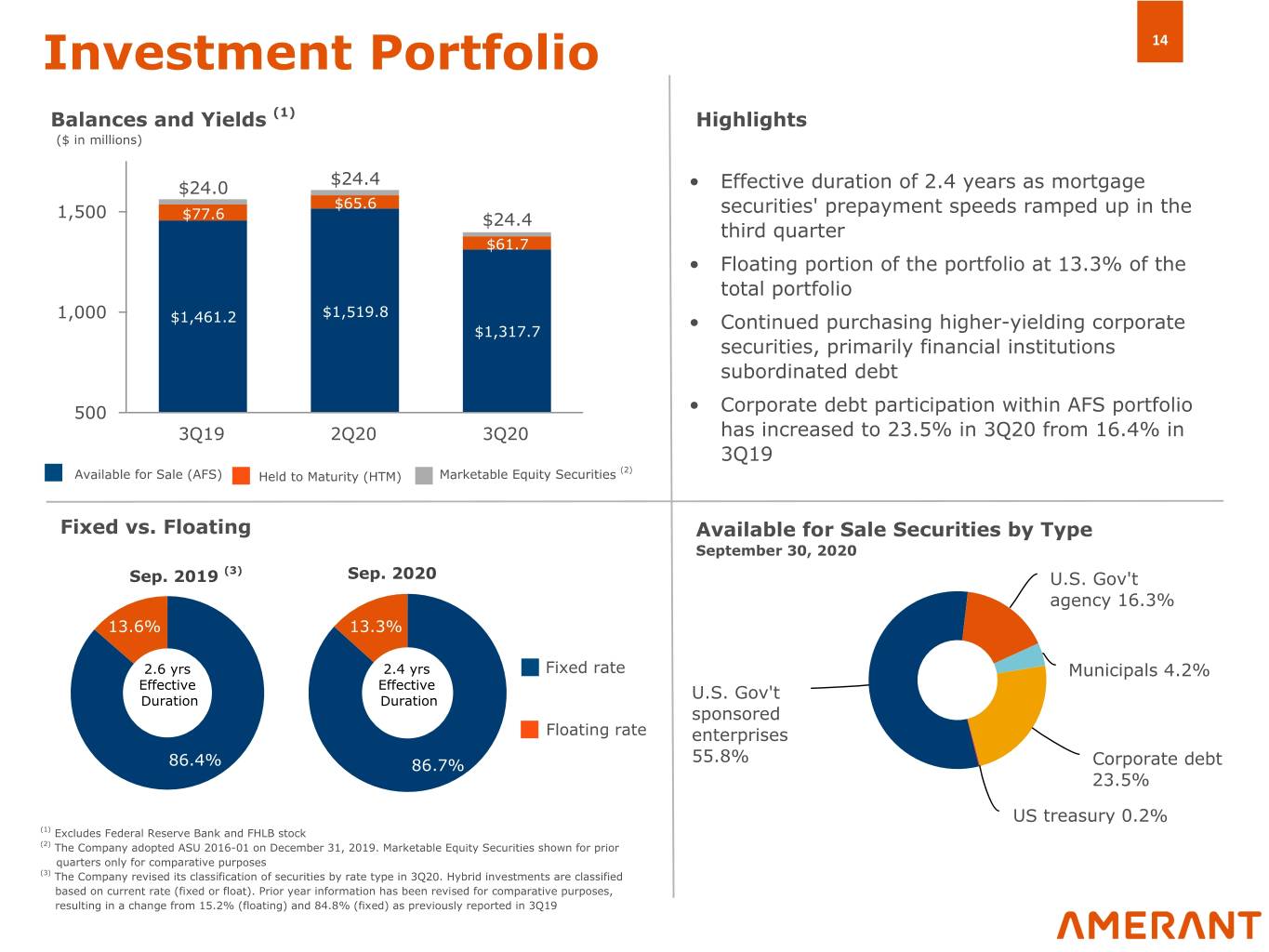
Investment Portfolio 14 Balances and Yields (1) Highlights ($ in millions) $24.4 $24.0 • Effective duration of 2.4 years as mortgage $65.6 securities' prepayment speeds ramped up in the 1,500 $77.6 $24.4 third quarter $61.7 • Floating portion of the portfolio at 13.3% of the total portfolio 1,000 $1,461.2 $1,519.8 $1,317.7 • Continued purchasing higher-yielding corporate securities, primarily financial institutions subordinated debt 500 • Corporate debt participation within AFS portfolio 3Q19 2Q20 3Q20 has increased to 23.5% in 3Q20 from 16.4% in 3Q19 (2) Available for Sale (AFS) Held to Maturity (HTM) Marketable Equity Securities Fixed vs. Floating Available for Sale Securities by Type September 30, 2020 (3) Sep. 2019 Sep. 2020 U.S. Gov't agency 16.3% 13.6% 13.3% 2.6 yrs 2.4 yrs Fixed rate Municipals 4.2% Effective Effective Duration Duration U.S. Gov't sponsored Floating rate enterprises 55.8% 86.4% 86.7% Corporate debt 23.5% US treasury 0.2% (1) Excludes Federal Reserve Bank and FHLB stock (2) The Company adopted ASU 2016-01 on December 31, 2019. Marketable Equity Securities shown for prior quarters only for comparative purposes (3) The Company revised its classification of securities by rate type in 3Q20. Hybrid investments are classified based on current rate (fixed or float). Prior year information has been revised for comparative purposes, resulting in a change from 15.2% (floating) and 84.8% (fixed) as previously reported in 3Q19

15 Strategic Shift in Loan Mix Yielding Benefits Loan Portfolio Loan Mix by Geography September 30, 2020 December 31, 2015 September 30, 2020 Financial Institutions & Acceptances 0.3% Consumer 3.2% 24.2% 97.4% 1-4 Family 10.1% 75.8% C&I 20.2% 2.6% § Domestic § International CRE 50.4% Highlights Owner Occupied CRE 15.8% • Continued focus on domestic lending activities. Domestic loan CAGR of 6.6% since 2015 • Average loan yields have increased from 3.06% in 2015 to 3.90% in September 2020 • Diversified portfolio - highest sector concentration, other than real estate, at 10.1% of total loans (1) Total: $5.9 billion • 76% of total loans secured by real estate (1) • Planned reduction of foreign financial institution (FI) and non- relationship SNC loans (C&I) was completed during 2019 Targeted reduction in international loan portfolio, coupled with growth in domestic C&I, CRE, and residential mortgages, has resulted in a better risk-adjusted loan book (1) See "Supplemental Information COVID-19"

16 Balanced CRE Loan Portfolio CRE Portfolio CRE Loan Mix by Primary Market Area(1) September 30, 2020 September 30, 2020 Hospitality 6.4% Miami-Dade, Broward, and Greater Palm Beach Houston 15.1% counties 53.6% New York City Retail Multifamily area 23.1% 37.1% 28.6% Other FL, TX, and NY/NJ 8.2% Highlights (2) Office 13.7% • Well diversified among geographies and property types, with Industrial + Land+ construction representing 11.2% Warehouse Construction 2.9% 11.2% • Conservative weighted average LTV 60% and DSC 1.7x • Strong sponsorship profile Total: $3.0 billion • No significant tenant concentration in CRE retail loan portfolio, where the top 15 tenants represent 40% of the total. Major tenants include recognized national food and health retailers Our CRE loan portfolio is highly diversified across geographies and industry segments (1) Primary market areas are Miami-Dade, Broward, and Palm Beach counties; Dallas and the Greater Houston market area; and the New York City area, including all five boroughs (2) See "Supplemental Information COVID-19"

Disciplined Credit Culture 17 Robust Underwriting Standards Non-performing Assets(2) / Total Assets • Credit quality remains sound and reserve coverage is strong 1.50% • Provision for loan losses of $18.0 million in the third quarter 2020; lowest recorded in any quarter this year and reflects improving 1.08% credit conditions on higher risk loans to borrowers as economic 1.00% activity increases • Loan forbearance balances declined to their lowest point since the start of the COVID-19 pandemic ($71.8 as of October 23, 2020) 0.50% • 3Q20 net charge-offs, non-performing assets and ALL include $19.3 million, $19.6 million and $5.8 million, respectively, related to Miami-based U.S. Coffee Trader 0.00% 2015 2016 2017 2018 2019 3Q20 Net Charge-Offs / Average Total Loans (1) Allowance for Loan Losses / Total Loans(3) 0.60% 0.56% 1.97% 2.00% 0.45% 1.50% 0.30% 1.00% 0.15% 0.50% 0.00% 0.00% 2015 2016 2017 2018 2019 3Q20 YTD 2015 2016 2017 2018 2019 3Q20 Amerant US Peer Median(4) Prudent underwriting across portfolios has translated into exceptional credit performance (1) Calculated based upon the average daily balance of outstanding loan principal balance net of deferred loan fees and costs, excluding the allowance for loan losses. During the third quarter of 2020, the Company charged off $19.3 million against the allowance for loan losses as result of the deterioration of one commercial loan relationship. Operating data for the periods presented has been annualized (2) Non-performing assets include all accruing loans past due 90 days or more, all nonaccrual loans, restructured loans that are considered “troubled debt restructurings” or “TDRs”, and OREO properties acquired through or in lieu of foreclosure (3) Outstanding loans are net of unamortized deferred loan origination fees and costs. 2015 and 2017 include loans held for sale of $9.7 million and $5.6 million, respectively. There were no loans held for sale at any of the other dates presented (4) Peer data is not yet available for 3Q20. Peers include BRKL, CADE, CNOB, DCOM, FFIC, HOMB, INDB, IBTX, IBOC, LBAI, SBCF, TOWN, TRMK. Source: S&P Global Market Intelligence. Peer group updated in 1Q20

18 Highly Attractive Deposit Franchise (1) Highlights Deposit Mix Jumbo Time • Focused on developing domestic relationships as opposed to rate (2) September 30, 2020 13.0% sensitive, non-relationship time deposits NIB Demand 15.6% • Working on protecting and growing low cost deposits • Experienced 11% CAGR in domestic deposits as a result of increased cross-selling efforts Retail Time Total Deposits: 25.4% (3) • Foreign deposits decreased 0.9%, in 3Q20 compared to an increase of $5.9 billion IB Demand 0.1% in 2Q20 and a decline of 16.0% in 3Q19. While there was a 20.5% (4) decline this quarter, the pace of such decline continues to slow down. The year-over-year annualized decay rate of foreign deposits in the third quarter of 2019 was approximately 14%. MMDA & Savings,25.5% • Brokered CDs declined $101.2 million, or 17.2%, compared to 2Q20 International Deposits Domestic Deposits ($ in millions) ($ in millions) ~ 11% Compounded Annual Decline Rate ~11% CAGR $4,490 $3,310 $3,001 $3,122 $4,093 $2,823 $3,500 $2,484 $3,031 $2,635 $2,567 $2,030 2015 2016 2017 2018 2019 3Q20 2015 2016 2017 2018 2019 3Q20 % of 68.9% 43.7% 31.1% 56.3% Total Deposits Strategic focus on maintaining international deposits while steadily growing domestic deposit base (1) Based on Bank’s September 30, 2020 Call Report (2) Defined as time deposits equal or greater that $100,000 (3) Includes brokered deposits of $487 million (4) Includes brokered deposits of $22 million

Wholesale Funding (1) & Debt (2) by Maturity 19 September 30, 2020 ($ in millions) Year of Maturity Interest Rate 3Q19 2Q20 3Q20 2023 and after 2019 1.80% to 2.28% $ 195 $ — $ — 72.9% 2020 1.50% to 2.56% 325 — — 2021 1.93% to 3.08% 240 — — 2022 0.65% to 2.80% 320 50 50 2023 and (4) (5) after 0.62% to 8.90% 182 1,123 1,123 Total (3) $ 1,262 $ 1,173 $ 1,173 Weighted Average Interest Rate for Period 2.38% 1.52% 1.51% (4) 2022 13.2% 3Q20 and 2Q20 include $530 million in callable advances with fixed interest rates ranging from 0.62% to 0.97% No contractual (5) Includes senior notes issued in 2Q20 totaling $58.5 million and $58.4 million as of September 30, 2020 and June 30, 2020, respectively (fixed interest rate - 5.75%) 2021 10.4% maturity 1.3% 2020 2.2% Brokered Deposits ($ in millions) 3Q19 2Q20 3Q20 $ 566 $ 588 $ 508 Highlights • In April 2020, we modified maturities on $420.0 million fixed-rate FHLB advances resulting in 26 bps of annual savings for this portfolio and representing $2.4 million cost savings for the rest of 2020 (1) Wholesale funding includes FHLB advances and brokered deposits (2) Debt includes senior notes and junior subordinated debentures

20 Interest Income and Margin Trends Highlights Impact on NII from Interest Rate Change (2) ($ in Millions and percentages) • Proactive steps in 3Q20 to preserve NIM: (As of September 30, 2020) ◦ Strategic deposit rate cuts on CDs and relationship money market accounts, in addition to maturities of high-yield 3.5% professional funding, have contributed to significantly lower 2.1% the overall cost of funds 200 0.0% ◦ Actively implemented floor rates and increased spreads -1.7% during extensions and renewals in order to optimize yields in -2.6% the credit portfolio ◦ Continue to optimize investment portfolio yields and manage balance sheet sensitivity to mitigate impact on NIM via 175 $196 $189 $193 duration $184 $186 • The Company continues to be asset sensitive as over half of loans have floating rate structures or mature within a year 150 -50 bps -25 bps BASE +25 bps +50 bps Net Interest Income Change from base Loan Yield Gap (1) Net Interest Margin (1) 3.95% 3.77% Yield gap between Amerant and peers has narrowed by 3.69% 3.65% 3.50% 2.78% 2.85% 2.63% 1.50% 2.48% 2.49% 2.26% 100 bps 0.97% 0.68% 0.54% 0.47% 0.50% 2015 2016 2017 2018 2019 2Q20 YTD 2015 2016 2017 2018 2019 3Q20 YTD Amerant Peer Median Continued improvement in Loan Yields and NIM (1) Peer data is not yet available for 3Q20. Peers are BRKL, CADE, CNOB, DCOM, FFIC, HOMB, INDB, IBTX, IBOC, LBAI, SBCF, TOWN, TRMK, when data is available in source. Source: S&P Global Market Intelligence. Peer group updated in 1Q20 (2) Assumes a static balance sheet and instantaneous and parallel interest rate shocks to the yield curve

21 Wealth Management Franchise Expansion Key Component of Noninterest Income 2020 YTD Noninterest Income Mix Wealth Management Platform Total: $62.0 million Deposits and service fees Amerant Trust Amerant Investments 18.8% • Estate Planning • Brokerage Services • Asset Protection • Investment Other non- • Escrow Services Advisory Services interest income Brokerage,advisor… 60.6% (3) 20.6% Noninterest Income as a % of Operating Highlights Revenue (1)(2) • In 4Q19, acquired Grand Cayman-based trust company subsidiary, 26.6% Elant Bank & Trust Ltd. $195 million in AUM acquired 23.8% 24.2% 23.8% 23.0% 21.2% • $1.76 billion in assets under management/custody 20.4% 20.0% 19.5% 17.4% 15.8% • Continued focus on domestic market to expand our footprint while retaining international clients • Deposit and service fees also contribute significant portion to noninterest income • Brokerage and advisory fees continue to increase due to improved allocation of assets under management into advisory services and 2015 2016 2017 2018 2019 3Q20 YTD higher volume of customer trading activity, supported by online platform Amerant Peer Median Expansion of fee income capabilities a key focal point and growth lever (1) Peers are BRKL, CADE, CNOB, DCOM, FFIC, HOMB, INDB, IBTX, IBOC, LBAI, SBCF, TOWN, TRMK. Source: S&P Global Market Intelligence and is adjusted to exclude all securities gains and losses. Peer group updated in 1Q20 (2) Operating revenue is the result of net interest income before provision for loan losses plus noninterest income. Noninterest income excludes net securities gains of $26.0 million in 3Q20 YTD. Years 2019, 2018, 2017, 2016 and 2015 exclude net securities gains and (losses) of $2.6 million, $(1.0) million, $(1.6) million, $1.0 million and $1.1 million, respectively. Years 2019 and 2017, also exclude $2.8 million gain on sale of vacant Beacon land and $10.5 million gain on sale of the NY building, respectively (3) Includes $25.4 million of gains on sale of securities

22 Increasing Operating Efficiency Cost Initiatives Efficiency Ratio (1) 1. Simplification of business model and product offerings following 84.7% Rationalization spin-off of Business 78.0% 78.8% 77.5% 2. De-emphasized international Lines 73.8% business resulting in less complexity and reduced costs 62.7% 1. Investments in technology are expected to generate efficiencies 2. FTEs down 200, or 19.9% since (3) 2015 2015 2016 2017 2018 2019 3Q20 YTD Head Count 3. Implemented voluntary early Reduction retirement plan ("VERP") and Net Interest Income as a % of Average involuntary severance plan ("ISP") Earnings Assets (2) to be completed by year end. 2.85% Estimated ISP annual savings of 2.78% approximately $5.8 million (4) 2.63% 1. Reduction and reorganization 2.48% 2.49% of existing office space to increase the amount available Space for lease to third parties 2.26% Efficiencies 2. Branch of the future model is smaller and optimizes customer interaction 2015 2016 2017 2018 2019 3Q20 YTD Simplification of business model and new technology initiatives will allow for a significant reduction in headcount and further improvement in the efficiency ratio (1) Balances annualized through September 30, 2020 (2) Includes loans, securities available for sale and held to maturity, deposits with banks and other financial assets, which yield interests or similar income (3) As of September 30, 2020 (4) VERP employees have 45 days to confirm participation. Costs and savings determined after this point. ISP will affect approximately 37 persons. ISP expected cost of approximately $1.9 million in the fourth quarter of 2020
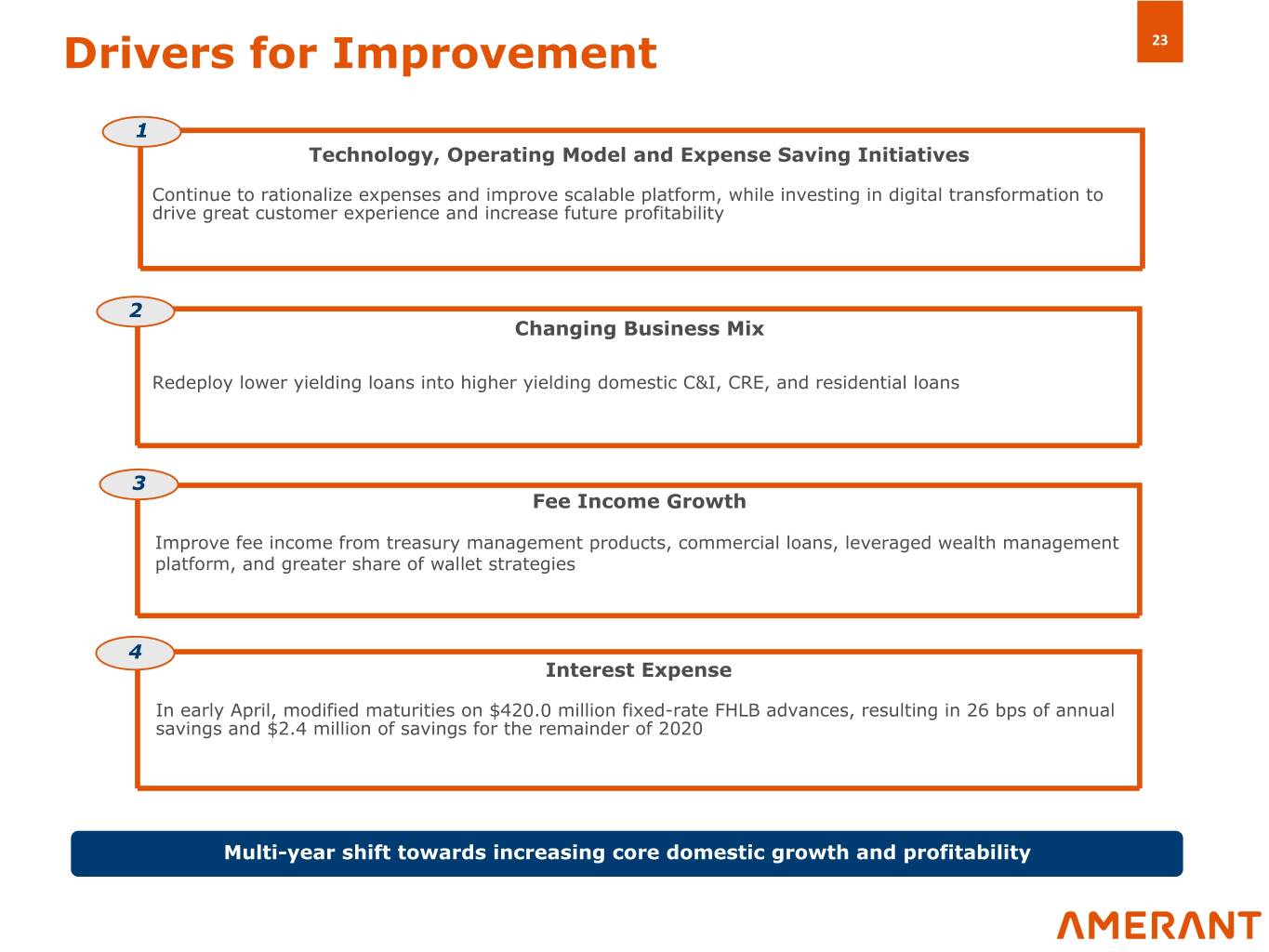
Drivers for Improvement 23 1 Technology, Operating Model and Expense Saving Initiatives Continue to rationalize expenses and improve scalable platform, while investing in digital transformation to drive great customer experience and increase future profitability 2 Changing Business Mix Redeploy lower yielding loans into higher yielding domestic C&I, CRE, and residential loans 3 Fee Income Growth Improve fee income from treasury management products, commercial loans, leveraged wealth management platform, and greater share of wallet strategies 4 Interest Expense In early April, modified maturities on $420.0 million fixed-rate FHLB advances, resulting in 26 bps of annual savings and $2.4 million of savings for the remainder of 2020 Multi-year shift towards increasing core domestic growth and profitability
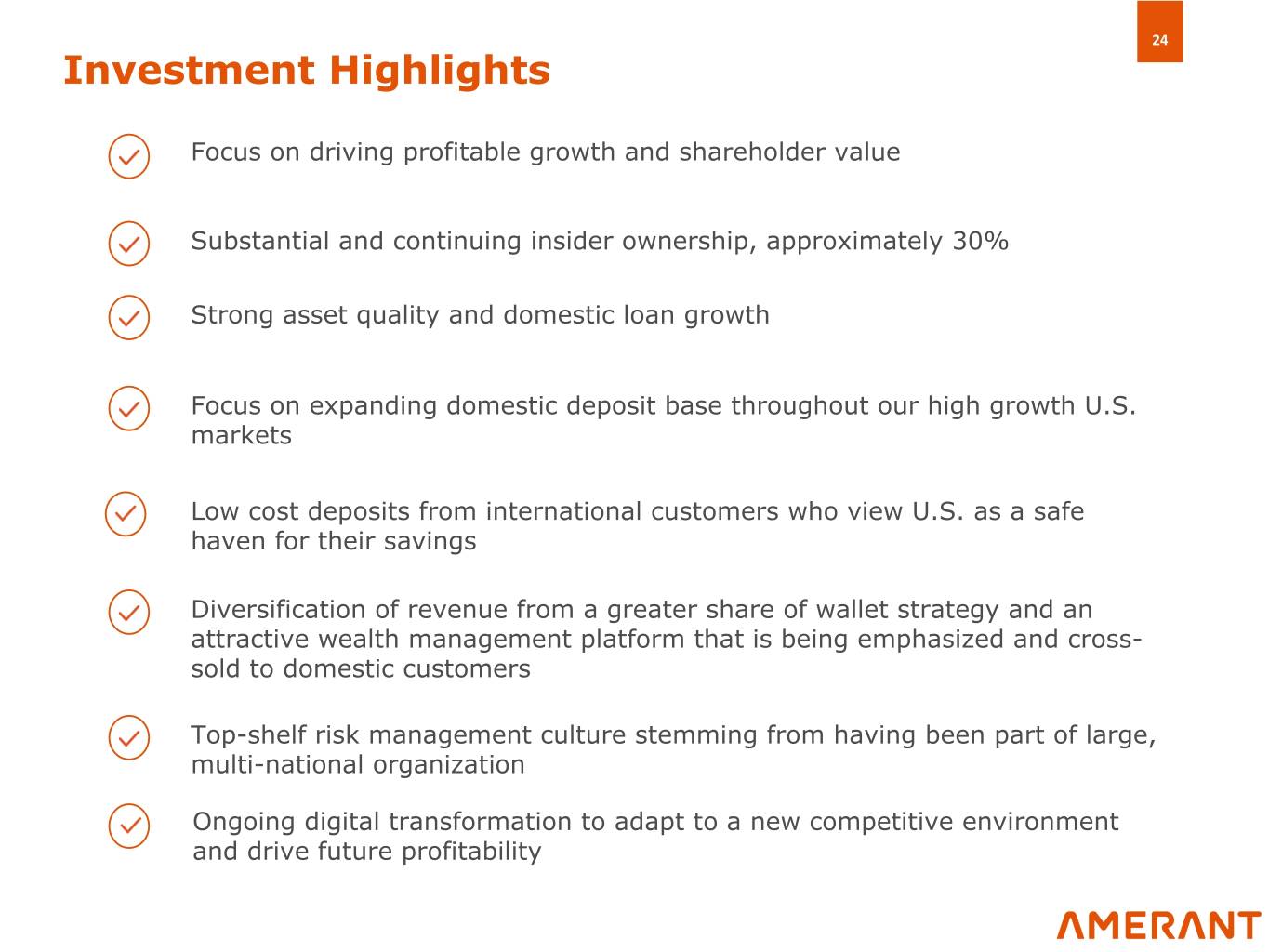
24 Investment Highlights Focus on driving profitable growth and shareholder value Substantial and continuing insider ownership, approximately 30% Strong asset quality and domestic loan growth Focus on expanding domestic deposit base throughout our high growth U.S. markets Low cost deposits from international customers who view U.S. as a safe haven for their savings Diversification of revenue from a greater share of wallet strategy and an attractive wealth management platform that is being emphasized and cross- sold to domestic customers Top-shelf risk management culture stemming from having been part of large, multi-national organization Ongoing digital transformation to adapt to a new competitive environment and drive future profitability
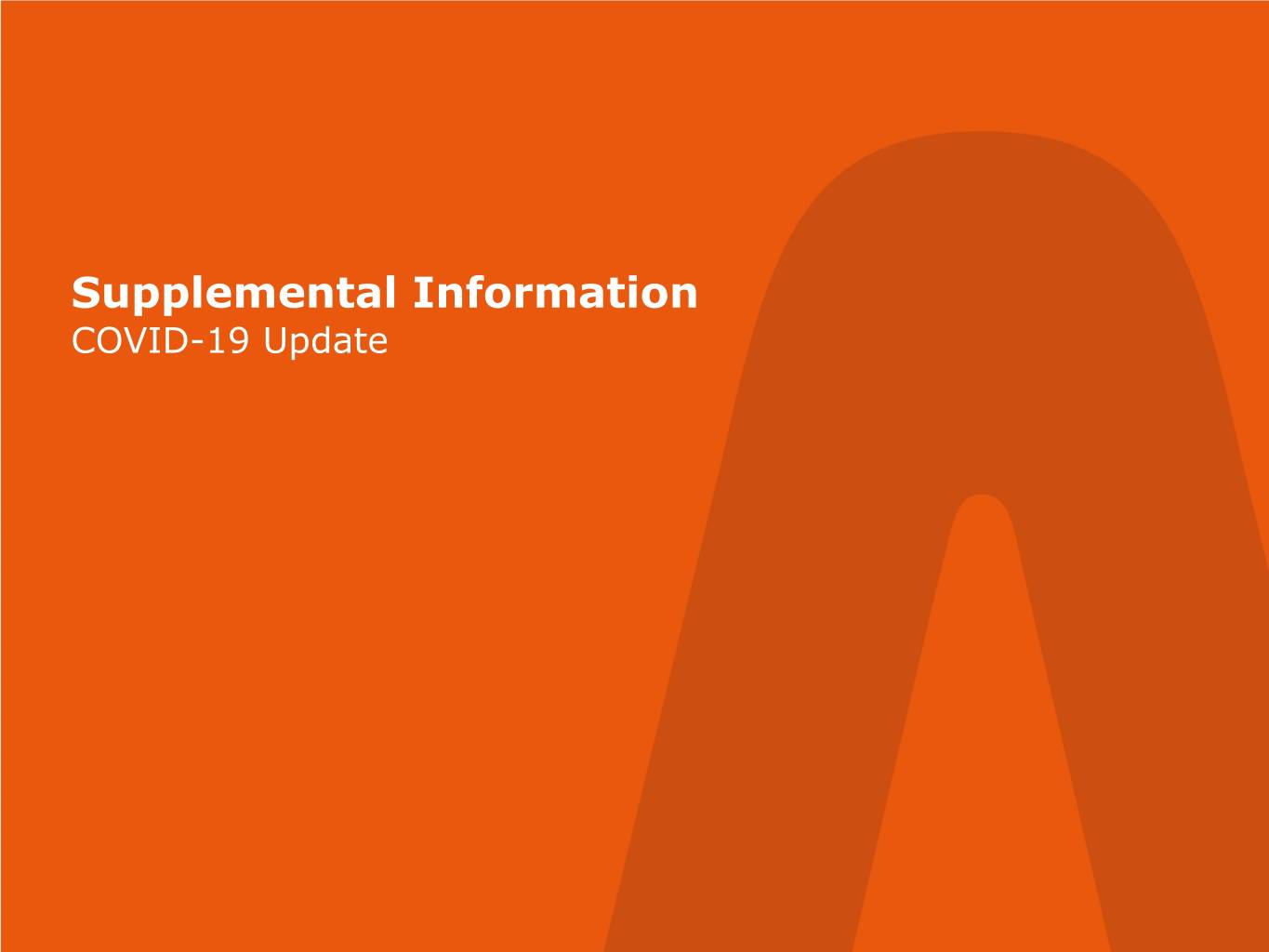
Supplemental Information COVID-19 Update
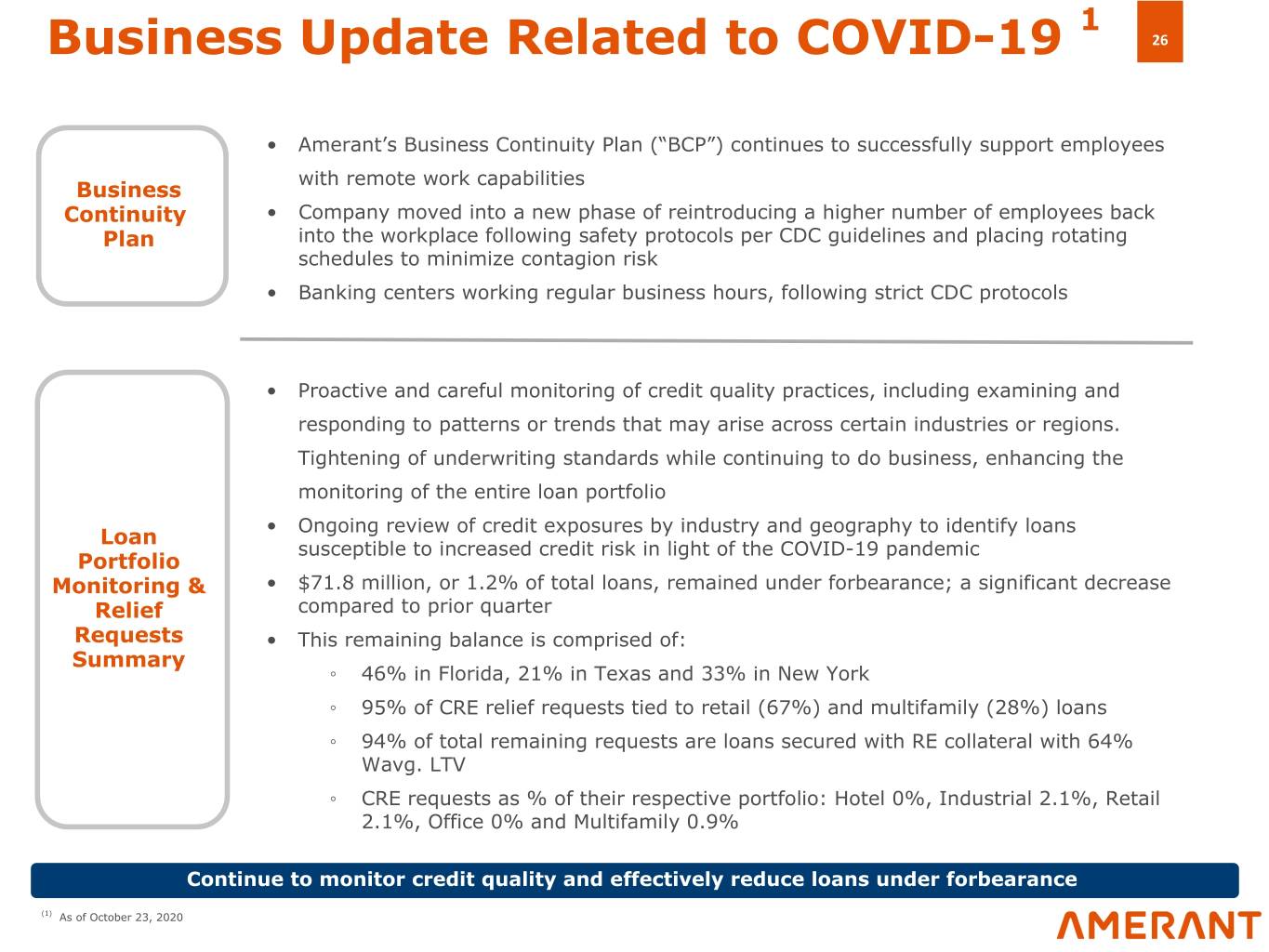
1 Business Update Related to COVID-19 26 • Amerant’s Business Continuity Plan (“BCP”) continues to successfully support employees with remote work capabilities Business Continuity • Company moved into a new phase of reintroducing a higher number of employees back Plan into the workplace following safety protocols per CDC guidelines and placing rotating schedules to minimize contagion risk • Banking centers working regular business hours, following strict CDC protocols • Proactive and careful monitoring of credit quality practices, including examining and responding to patterns or trends that may arise across certain industries or regions. Tightening of underwriting standards while continuing to do business, enhancing the monitoring of the entire loan portfolio • Ongoing review of credit exposures by industry and geography to identify loans Loan susceptible to increased credit risk in light of the COVID-19 pandemic Portfolio Monitoring & • $71.8 million, or 1.2% of total loans, remained under forbearance; a significant decrease Relief compared to prior quarter Requests • This remaining balance is comprised of: Summary ◦ 46% in Florida, 21% in Texas and 33% in New York ◦ 95% of CRE relief requests tied to retail (67%) and multifamily (28%) loans ◦ 94% of total remaining requests are loans secured with RE collateral with 64% Wavg. LTV ◦ CRE requests as % of their respective portfolio: Hotel 0%, Industrial 2.1%, Retail 2.1%, Office 0% and Multifamily 0.9% Continue to monitor credit quality and effectively reduce loans under forbearance (1) As of October 23, 2020

27 Loan portfolio by industry (September 30, 2020) Real Non-Real % Total Unfunded ($ in millions) Estate Estate Total Loans Commitments(8) Highlights Financial Sector (1) $ 5 $ 70 $ 75 1.3 % $ 18 Construction and Real Estate & Leasing: Commercial real estate loans 2,986 — 2,986 50.4 % 192 • Diversified portfolio - Other real estate related services and equipment leasing (2) 50 87 137 2.3 % 20 highest sector concentration, other than Total construction and real estate & leasing 3,036 87 3,123 52.7 % 212 real estate, at 10.4% of Manufacturing: total loans Foodstuffs, Apparel 74 32 106 1.8 % 4 Metals, Computer, Transportation and Other 16 120 136 2.3 % 20 • 76% of total loans Chemicals, Oil, Plastics, Cement and Wood/Paper 25 12 37 0.6 % 4 secured by real estate Total Manufacturing 115 164 279 4.7 % 28 Wholesale (3) 164 426 590 10.0 % 150 • Main concentrations: Retail Trade (4) 257 156 413 7.0 % 41 • CRE or Commercial Services: Real Estate (5) Communication, Transportation, Health and Other 240 172 412 7.0 % 32 • Wholesale - Food Accommodation, Restaurants, Entertainment and other services (6) 100 72 172 2.9 % 27 • Retail - Gas stations Electricity, Gas, Water, Supply and Sewage Services 6 29 35 0.6 % 3 Total Services 346 273 619 10.4 % 63 • Services – Healthcare, Repair and Primary Products: Maintenance Agriculture, Livestock, Fishing and Forestry — 1 1 — % — Mining — 3 3 0.1 % — Total Primary Products — 4 4 0.1 % — Other Loans (7) 598 225 823 13.9 % 223 Total Loans $ 4,521 $ 1,405 $ 5,926 100.0 % $ 735 (1) Consists mainly of finance facilities granted to non-bank financial companies. (2) Comprised mostly of construction and real estate related services and equipment rental and leasing activities (3) Food wholesalers represented approximately 40% (4) Gasoline stations represented approximately 60% (5) Healthcare represented approximately 57% (6) Other repair and maintenance services represented 53% (7) Primarily residential, consumer loans, and cash secured loans and loans belonging to industrial sectors not included in the above sectors, which do not individually represent more than 1 percent of the total loans portfolio (8) Not all unfunded commitments are unilaterally available to borrowers. For example, certain revolving loans and asset based lending loans require borrowers provide additional collateral to access the full amount of the commitment

Industries with escalated monitoring 28 CRE Hotels (As of 09/30/2020) Hotels Hotels - LTV 50% 38% Boutique 40% 29% 31% 30% Full Service 20% 14% 38% 12% Limited Service 10% 5% 33% 0% 50% or 50- 60- 70- 80% or less 60% 70% 80% more Total: $271 million Loan Portfolio Percentage: 4.6% Highlights • CRE Hotel portfolio is limited to 27 properties, majority of which are in popular travel destinations such as Miami Beach (#9 / $106 MM) and New York (#2 / $60 MM) • Three hotel construction loans to borrowers who are experienced hotel operators within their markets with significant equity and resources as well as previous construction track record with the Bank • To date, hotel construction projects continue on budget and without significant delays • None of the hotel loans are under forbearance
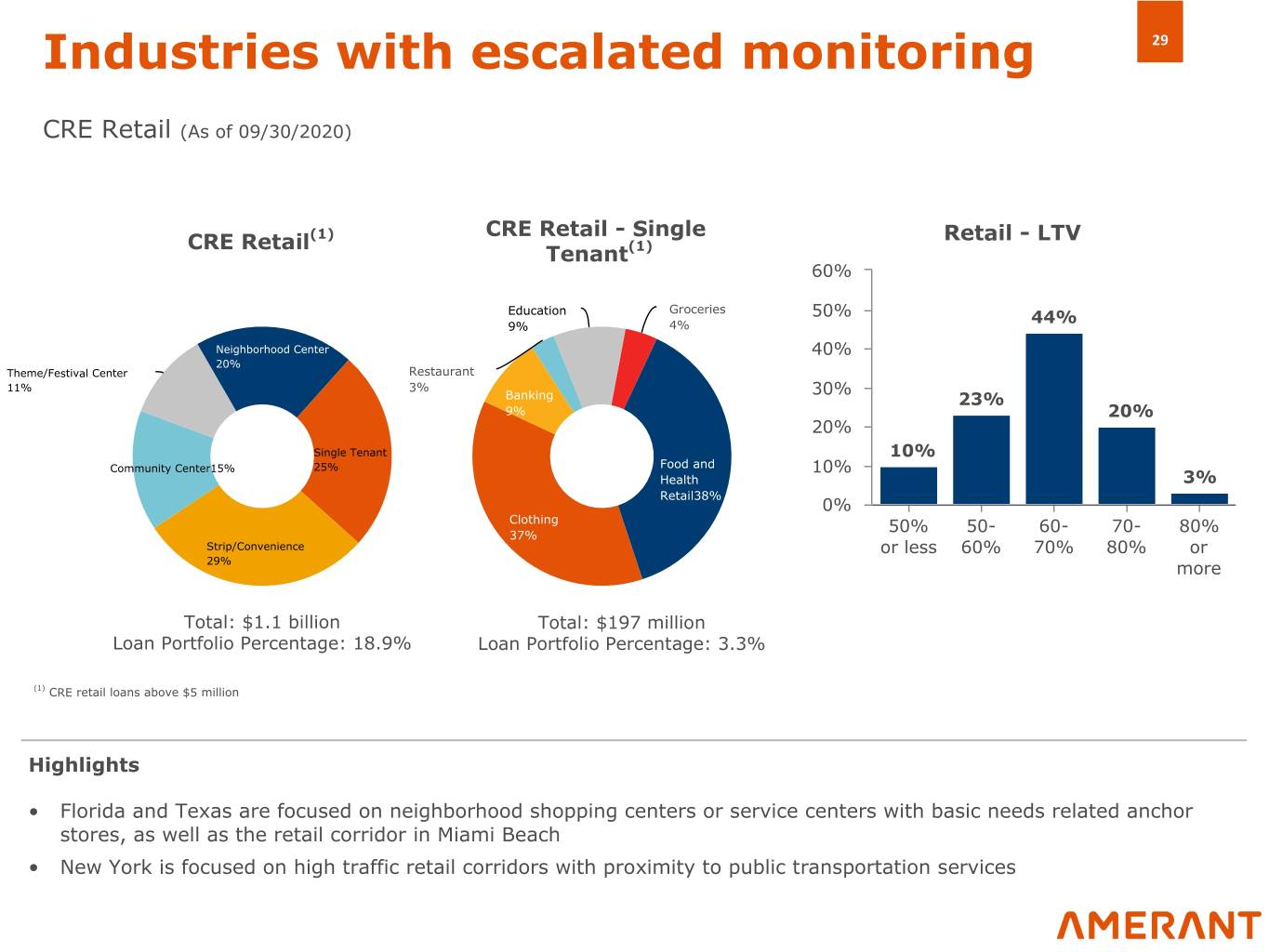
Industries with escalated monitoring 29 CRE Retail (As of 09/30/2020) (1) CRE Retail - Single Retail - LTV CRE Retail (1) Tenant 60% Education Groceries 50% 44% 9% 4% Neighborhood Center 40% 20% Theme/Festival Center Restaurant 11% 3% 30% Banking 23% 9% 20% 20% Single Tenant 10% Community Center15% 25% Food and 10% Health 3% Retail38% 0% Clothing 50% 50- 60- 70- 80% 37% Strip/Convenience or less 60% 70% 80% or 29% more Total: $1.1 billion Total: $197 million Loan Portfolio Percentage: 18.9% Loan Portfolio Percentage: 3.3% (1) CRE retail loans above $5 million Highlights • Florida and Texas are focused on neighborhood shopping centers or service centers with basic needs related anchor stores, as well as the retail corridor in Miami Beach • New York is focused on high traffic retail corridors with proximity to public transportation services

Appendices
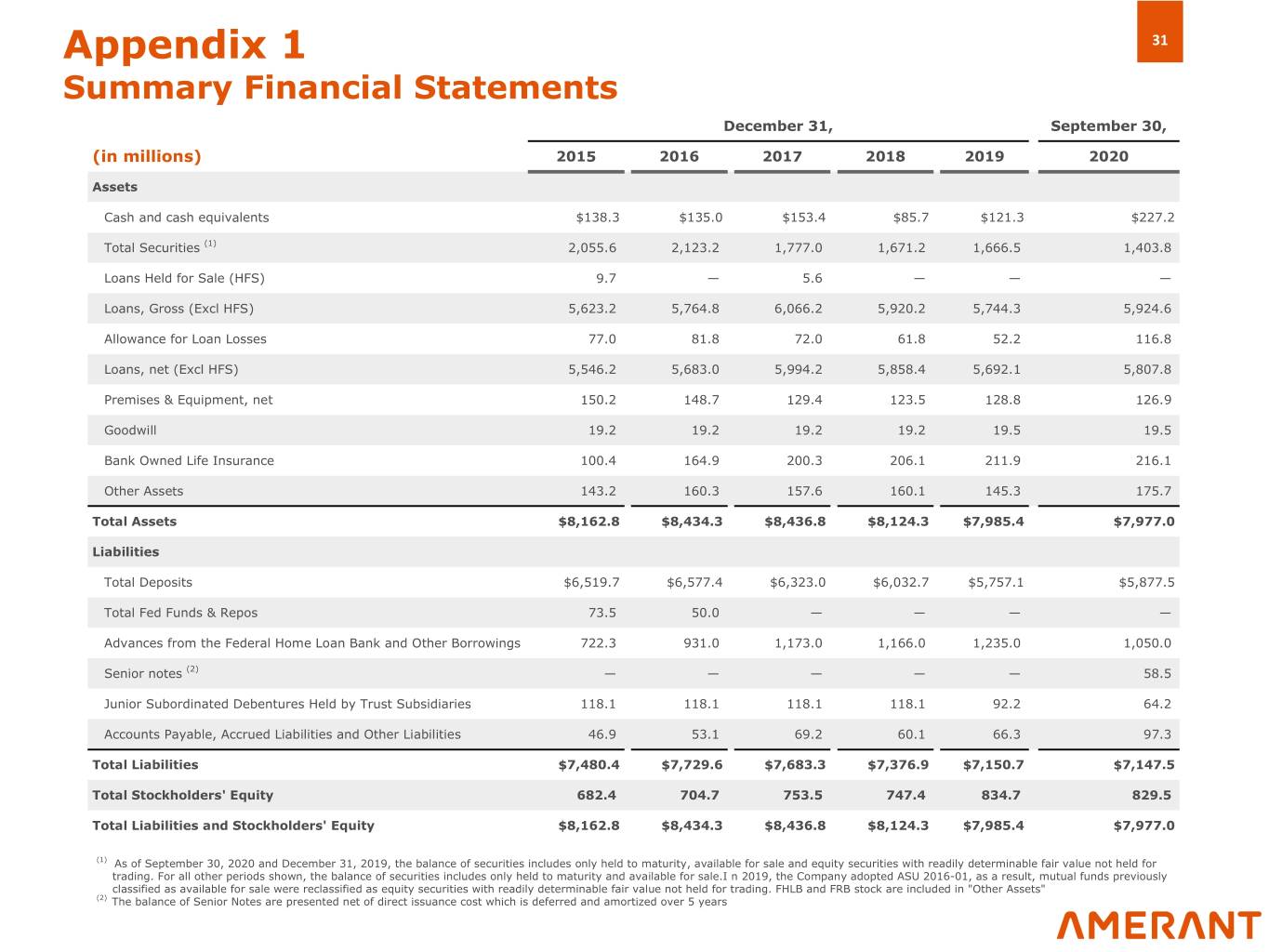
Appendix 1 31 Summary Financial Statements December 31, September 30, (in millions) 2015 2016 2017 2018 2019 2020 Assets Cash and cash equivalents $138.3 $135.0 $153.4 $85.7 $121.3 $227.2 Total Securities (1) 2,055.6 2,123.2 1,777.0 1,671.2 1,666.5 1,403.8 Loans Held for Sale (HFS) 9.7 — 5.6 — — — Loans, Gross (Excl HFS) 5,623.2 5,764.8 6,066.2 5,920.2 5,744.3 5,924.6 Allowance for Loan Losses 77.0 81.8 72.0 61.8 52.2 116.8 Loans, net (Excl HFS) 5,546.2 5,683.0 5,994.2 5,858.4 5,692.1 5,807.8 Premises & Equipment, net 150.2 148.7 129.4 123.5 128.8 126.9 Goodwill 19.2 19.2 19.2 19.2 19.5 19.5 Bank Owned Life Insurance 100.4 164.9 200.3 206.1 211.9 216.1 Other Assets 143.2 160.3 157.6 160.1 145.3 175.7 Total Assets $8,162.8 $8,434.3 $8,436.8 $8,124.3 $7,985.4 $7,977.0 Liabilities Total Deposits $6,519.7 $6,577.4 $6,323.0 $6,032.7 $5,757.1 $5,877.5 Total Fed Funds & Repos 73.5 50.0 — — — — Advances from the Federal Home Loan Bank and Other Borrowings 722.3 931.0 1,173.0 1,166.0 1,235.0 1,050.0 Senior notes (2) — — — — — 58.5 Junior Subordinated Debentures Held by Trust Subsidiaries 118.1 118.1 118.1 118.1 92.2 64.2 Accounts Payable, Accrued Liabilities and Other Liabilities 46.9 53.1 69.2 60.1 66.3 97.3 Total Liabilities $7,480.4 $7,729.6 $7,683.3 $7,376.9 $7,150.7 $7,147.5 Total Stockholders' Equity 682.4 704.7 753.5 747.4 834.7 829.5 Total Liabilities and Stockholders' Equity $8,162.8 $8,434.3 $8,436.8 $8,124.3 $7,985.4 $7,977.0 (1) As of September 30, 2020 and December 31, 2019, the balance of securities includes only held to maturity, available for sale and equity securities with readily determinable fair value not held for trading. For all other periods shown, the balance of securities includes only held to maturity and available for sale.I n 2019, the Company adopted ASU 2016-01, as a result, mutual funds previously classified as available for sale were reclassified as equity securities with readily determinable fair value not held for trading. FHLB and FRB stock are included in "Other Assets" (2) The balance of Senior Notes are presented net of direct issuance cost which is deferred and amortized over 5 years

32 Appendix 1 Summary Financial Statements (cont’d) Years ended December 31, Nine months ended 2015 2016 2017 2018 2019 September 30, (in thousands) 2020 Total Interest Income $208,199 $238,827 $273,320 $309,358 $312,974 $197,399 Total Interest Expense 35,914 46,894 63,610 90,319 99,886 56,499 Net Interest Income $172,285 $191,933 $209,710 $219,039 $161,826 $140,900 Provision for (Reversal of) Loan Losses 11,220 22,110 (3,490) 375 (3,150) 88,620 Total Noninterest Income 54,756 62,270 71,485 53,875 57,110 61,955 Total Noninterest Expense 192,262 198,303 207,636 214,973 209,317 127,107 Income (Loss) before Income Tax 23,559 33,790 77,049 57,566 64,031 (12,872) Income Tax (Expense) Benefit (8,514) (10,211) (33,992) (11,733) (12,697) 2,677 Net Income (Loss) $15,045 $23,579 $43,057 $45,833 $51,334 ($10,195)

33 Appendix 2 Non-GAAP Financial Measures Reconciliations Explanation of Certain Non-GAAP Financial Measures This Presentation contains certain adjusted financial information, and their effects on noninterest income, noninterest expense, income taxes, net income, operating income, efficiency ratios, ROA and ROE and certain other financial ratios. These adjustments include: • the $2.8 million net gain on the sale of vacant Beacon land during the fourth quarter of 2019, • the $10.5 million net gain on the sale of the Company’s New York City building during the third quarter of 2017, • the $9.6 million expense in the fourth quarter of 2017 resulting from the 2017 Tax Act, • spin-off expenses totaling $6.7 million in 2018, $5.2 million in 2017, beginning in the fourth quarter of 2017 and continuing to the fourth quarter of 2018, • the $6.4 million, $5.0 million and $3.5 million in restructuring expenses in 2018, 2019 and the first nine months of 2020, respectively, related to staff reduction costs, legal and strategic advisory costs, rebranding costs and digital transformation costs, • the securities gains of $26.0 million and $2.6 million in the first nine months of 2020 and year ended 2019, respectively, and securities losses of $1.0 million and $1.6 million in the years ended 2018 and 2017, respectively, • the provision for loan losses of $88.6 million and $0.4 million in the first nine months of 2020 and year ended 2018, respectively, and reversal of loan losses of $3.2 million and $3.5 million in the years ended 2019 and 2017, respectively, and • the income tax expense benefit of $2.7 million in the first nine months of 2020, and the income tax benefit of $12.7 million, $11.7 million and $34.0 million in the years ended 2019, 2018 and 2017, respectively. These as-adjusted measures are not in accordance with generally accepted accounting principles (“GAAP”). This Appendix 2 reconciles these adjustments to reported results. The Company uses certain non-GAAP financial measures, within the meaning of SEC Regulation G, which are included in this Presentation to explain our results and which are used in our internal evaluation and management of the Company’s businesses. The Company’s management believes these non-GAAP financial measures and the information they provide are useful to investors since these measures permit investors to view the Company’s performance using the same tools that management uses to evaluate the Company’s past performance and prospects for future performance. The Company believes these are especially useful in light of the effects of our spin-off and related restructuring expenses, as well as the sale of vacant Beacon land in the fourth quarter of 2019, the sale of our New York City building in third quarter 2017, the charges to our deferred tax assets in fourth quarter 2017 resulting from the enactment of the 2017 Tax Act in December 2017, and other adjustments mentioned above. No adjustments were made to the 2015 and 2016 financial information.
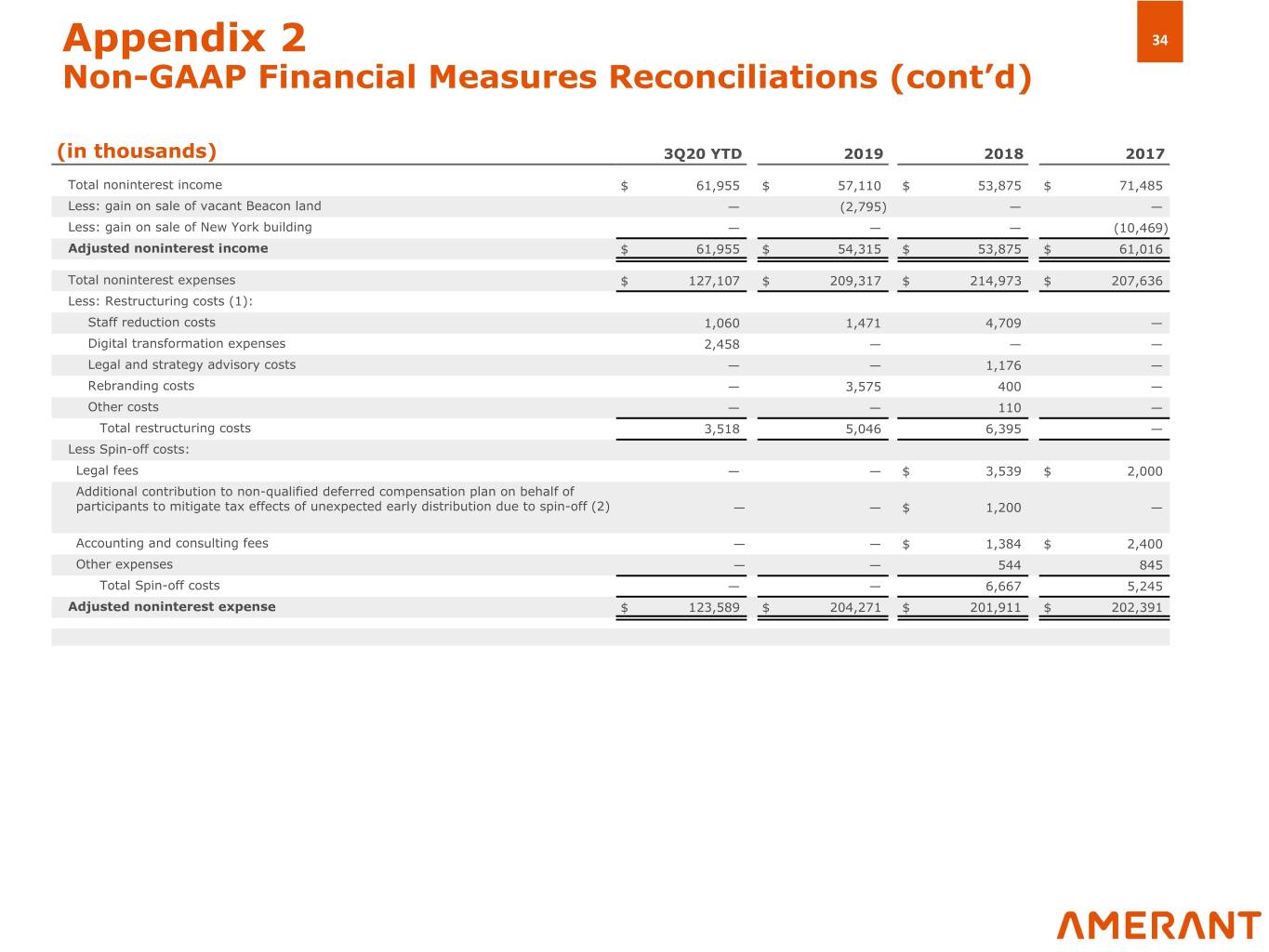
Appendix 2 34 Non-GAAP Financial Measures Reconciliations (cont’d) (in thousands) 3Q20 YTD 2019 2018 2017 Total noninterest income $ 61,955 $ 57,110 $ 53,875 $ 71,485 Less: gain on sale of vacant Beacon land — (2,795) — — Less: gain on sale of New York building — — — (10,469) Adjusted noninterest income $ 61,955 $ 54,315 $ 53,875 $ 61,016 Total noninterest expenses $ 127,107 $ 209,317 $ 214,973 $ 207,636 Less: Restructuring costs (1): Staff reduction costs 1,060 1,471 4,709 — Digital transformation expenses 2,458 — — — Legal and strategy advisory costs — — 1,176 — Rebranding costs — 3,575 400 — Other costs — — 110 — Total restructuring costs 3,518 5,046 6,395 — Less Spin-off costs: Legal fees — — $ 3,539 $ 2,000 Additional contribution to non-qualified deferred compensation plan on behalf of participants to mitigate tax effects of unexpected early distribution due to spin-off (2) — — $ 1,200 — Accounting and consulting fees — — $ 1,384 $ 2,400 Other expenses — — 544 845 Total Spin-off costs — — 6,667 5,245 Adjusted noninterest expense $ 123,589 $ 204,271 $ 201,911 $ 202,391

35 Appendix 2 Non-GAAP Financial Measures Reconciliations (cont’d) (in thousands) 3Q20 YTD 2019 2018 2017 Net (loss) income $ (10,195) $ 51,334 $ 45,833 $ 43,057 Plus after-tax restructuring costs: Restructuring costs before income tax effect 3,518 5,046 6,395 — Income tax effect (732) (1,001) (1,303) — Total after-tax restructuring costs 2,786 4,045 5,092 — Plus after-tax total Spin-off costs: Total Spin-off costs before income tax effect — — 6,667 5,245 Income tax effect (3) — — 331 (2,314) Total after-tax Spin-off costs — — 6,998 2,931 Less after-tax gain on sale of vacant Beacon land: Gain on sale of vacant Beacon land before income tax effect — (2,795) — — Income tax effect — 554 — — Total after-tax gain on sale of vacant Beacon land — (2,241) — — Less after-tax gain on sale of New York building: Gain on sale of New York building before income tax effect — — — (10,469) Income tax effect (4) — — — 3,320 Total after-tax gain on sale of New York building — — — (7,149) Plus impact of lower rate under the 2017 Tax Act: Remeasurement of net deferred tax assets, other than balances corresponding to — — — 8,470 items in AOCI Remeasurement of net deferred tax assets corresponding to items in AOCI — — — 1,094 Total impact of lower rate under the 2017 Tax Act — — — 9,564 Adjusted net (loss) income $ (7,409) $ 53,138 $ 57,923 $ 48,403 Net (loss) income $ (10,195) $ 51,334 $ 45,833 $ 43,057 Plus: income tax (benefit) expense (2,677) 12,697 11,733 33,992 Plus: provision (reversal) for loan losses 88,620 (3,150) 375 (3,490) Less: securities gains, net 25,957 2,605 (999) (1,601) Operating income $ 49,791 $ 63,486 $ 56,942 $ 71,958

Appendix 2 36 Non-GAAP Financial Measures Reconciliations (cont’d) 3Q20 YTD 2019 2018 2017 Basic (loss) earnings per share $ (0.24) $ 1.21 $ 1.08 $ 1.01 Plus: after tax impact of restructuring costs 0.06 0.09 0.12 — Plus: after tax impact of total spin-off costs — — 0.16 0.07 Plus: effect of lower rate under the 2017 Tax Act — — — 0.23 Less: after tax gain on sale of vacant Beacon land — (0.05) — — Less: after-tax gain on sale of New York building — — — (0.17) Total adjusted basic (loss) earnings per common share $ (0.18) $ 1.25 $ 1.36 $ 1.14 Diluted (loss) earnings per share (5) $ (0.24) $ 1.20 $ 1.08 $ 1.01 Plus: after tax impact of restructuring costs 0.06 0.09 0.12 — Plus: after tax impact of total spin-off costs — — 0.16 0.07 Plus: effect of lower rate under the 2017 Tax Act — — — 0.23 Less: after tax gain on sale of vacant Beacon land — (0.05) — — Less: after-tax gain on sale of New York building — — — (0.17) Total adjusted diluted (loss) earnings per common share $ (0.18) $ 1.24 $ 1.36 $ 1.14 Net (loss) income / Average total assets (ROA) (0.17) % 0.65 % 0.55 % 0.51 % Plus: after tax impact of restructuring costs 0.05 % 0.05 % 0.06 % — % Plus: after tax impact of total spin-off costs — % — % 0.08 % 0.03 % Plus: effect of lower rate under the 2017 Tax Act — % — % — % 0.11 % Less: after tax gain on sale of vacant Beacon land — % (0.03) % — % 0.00 % Less: after-tax gain on sale of New York building — % — % — % (0.08) % Adjusted net (loss) income / Average total assets (Adjusted ROA) (0.12) % 0.67 % 0.69 % 0.57 % Net (loss) income / Average stockholders' equity (ROE) (1.62) % 6.43 % 6.29 % 5.62 % Plus: after tax impact of restructuring costs 0.45 % 0.51 % 0.70 % — % Plus: after tax impact of total spin-off costs — % — % 0.96 % 0.38 % Plus: effect of lower rate under the 2017 Tax Act — % — % — % 1.25 % Less: after tax gain on sale of vacant Beacon land — % (0.28) % — % 0.00 % Less: after-tax gain on sale of New York building — % — % — % (0.93) % Adjusted net (loss) income / stockholders' equity (Adjusted ROE) (1.17) % 6.66 % 7.95 % 6.32 %

37 Appendix 2 Non-GAAP Financial Measures Reconciliations (cont’d) (in thousands, except per share data and percentages) 3Q20 YTD 2019 2018 2017 Efficiency ratio 62.66 % 77.47 % 78.77 % 73.84 % Less: impact of restructuring costs (1.74) % (1.89) % (2.34) % — % Less: impact of total spin-off costs — % — % (2.44) % (1.86) % Plus: gain on sale of vacant Beacon land — % 0.81 % — % — % Plus: gain on sale of New York building —% — % — % 2.78 % Adjusted efficiency ratio 60.92 % 76.39 % 73.99 % 74.76 % Total noninterest income $ 61,955 $ 57,110 $ 53,875 $ 71,485 Less: securities gains, net 25,957 2,605 (999) (1,601) Less: net gain on sale of properties — 2,795 — 10,469 Adjusted noninterest income for operating revenue $ 35,998 $ 51,710 $ 54,874 $ 62,617 Net interest income before provision 140,900 213,088 219,039 209,710 Operating revenue 176,898 264,798 273,913 272,327 Adjusted noninterest income as a % of operating revenue 20.3 % 19.5 % 20.0 % 23.0 % Tangible common equity ratio: Stockholders' equity $ 829,533 $ 834,701 $ 747,418 $ 753,450 Less: Goodwill and other intangibles (21,607) (21,744) (21,042) (21,186) Tangible common stockholders' equity $ 807,926 $ 812,957 $ 726,376 $ 732,264 Total assets 7,977,047 7,985,399 8,124,347 8,436,767 Less: Goodwill and other intangibles (21,607) (21,744) (21,042) (21,186) Tangible assets $ 7,955,440 $ 7,963,655 $ 8,103,305 $ 8,415,581 Common shares outstanding 42,147 43,146 43,183 42,489 Tangible common equity ratio 10.16 % 10.21 % 8.96 % 8.70 % Stockholders' book value per common share $ 19.68 $ 19.35 $ 17.31 $ 17.73 Tangible stockholders' book value per common share $ 19.17 $ 18.84 $ 16.82 $ 17.23 (1) Expenses incurred for actions designed to implement the Company’s strategy as a new independent company. These actions include, but are not limited to, reductions in workforce, streamlining operational processes, rolling out the Amerant brand, implementation of new technology system applications, enhanced sales tools and training, expanded product offerings and improved customer analytics to identify opportunities (2) The spin-off caused an unexpected early distribution for U.S. federal income tax purposes from our deferred compensation plan. This distribution was taxable to plan participants as ordinary income during 2018. We partially compensated plan participants, in the aggregate amount of $1.2 million, for the higher tax expense they incurred as a result of the distribution increasing the plan participants' estimated effective federal income tax rates by recording a contribution to the plan on behalf of its participants. The after tax net effect of this $1.2 million contribution for the period ended September 30, 2018, was approximately $952,000. As a result of the early taxable distribution to plan participants, we expensed and deducted for federal income tax purposes, previously deferred compensation of approximately $8.1 million, resulting in an estimated tax credit of $1.7 million, which exceeded the amount of the tax gross-up paid to plan participants (3) Calculated based upon the estimated annual effective tax rate for the periods, which excludes the tax effect of discrete items, and the amounts that resulted from the permanent difference between spin-off costs that are non-deductible for Federal and state income tax purposes, and total spin-off costs recognized in the consolidated financial statements. The estimated annual effective rate applied for the calculation differs from the reported effective tax rate since it is based on a different mix of statutory rates applicable to these expenses and to the rates applicable to the Company and its subsidiaries (4) Calculated based upon an estimated annual effective rate of 31.71% (5) As of September 30, 2020 and December 31, 2019, potential dilutive instruments consisted of unvested shares of restricted stock and restricted stock units mainly related to the Company’s IPO in 2018, totaling 478,757 and 530,620, respectively. As of September 30, 2020, potential dilutive instruments were not included in the dilutive earnings per share computation because the Company reported a net loss and their inclusion would have an antidilutive effect. As of December 31, 2019, potential dilutive instruments were included in the diluted earnings per share computation because, when the unamortized deferred compensation cost related to these shares was divided by the average market price per share at those dates, fewer shares would have been purchased than restricted shares assumed issued. Therefore, at that date, such awards resulted in higher diluted weighted averages shares outstanding than basic weighted average shares outstanding, and had a dilutive effect in per share earnings. We had no outstanding dilutive instruments as of any period prior to December 2018

Thank you
